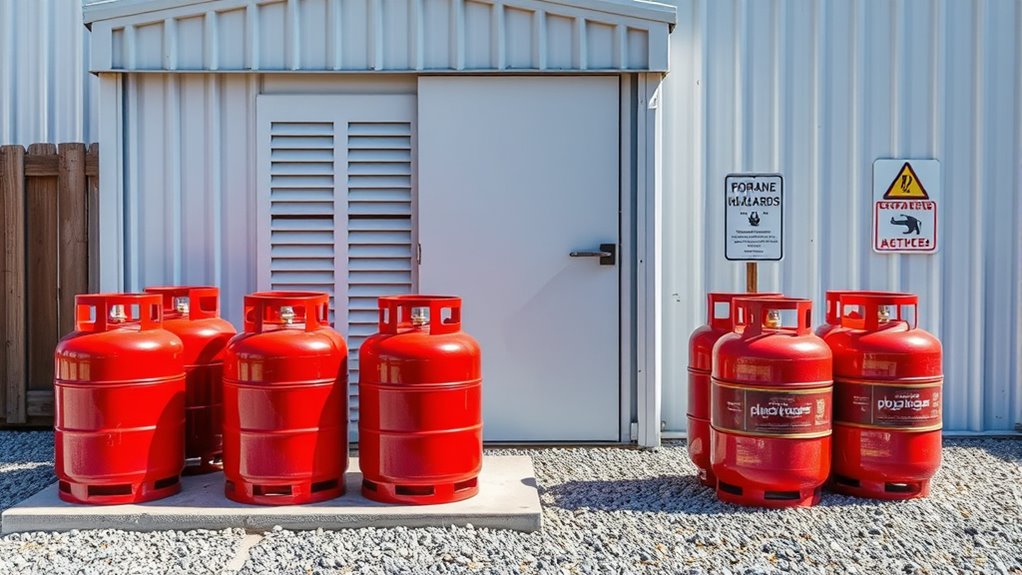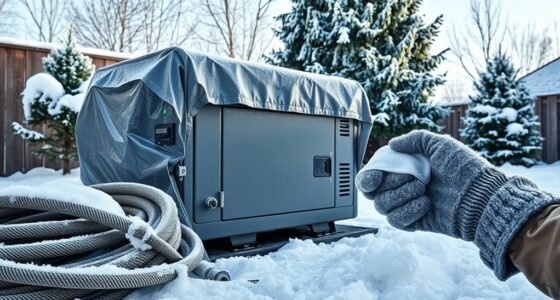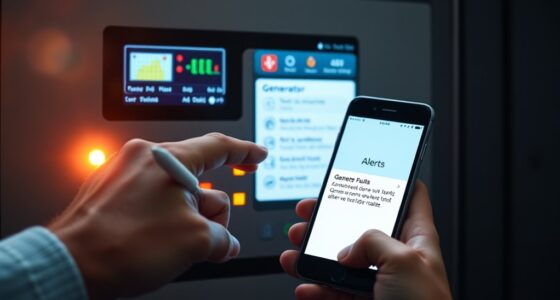To safely store and rotate propane at home, keep tanks outside in well-ventilated, shaded areas at least 10 to 25 feet from your home and ignition sources. Always store cylinders upright with relief valves on top, and inspect them regularly for rust, leaks, or damage. Use proper supports and secure tanks during transport to prevent accidents. For effective rotation, mark tanks with purchase or refill dates and use the oldest first. Continue exploring for more safety tips.
Key Takeaways
- Store propane tanks upright in well-ventilated, shaded areas at least 10-20 feet from buildings and ignition sources.
- Regularly inspect tanks for rust, leaks, or damage, and perform leak tests on fittings and valves.
- Use the oldest propane tanks first, labeling them with purchase or refill dates to ensure proper rotation.
- Secure tanks during storage and transport with straps or supports to prevent tipping or movement.
- Follow all safety guidelines for handling, maintaining, and storing tanks, including proper orientation and distance from structures.
Choosing the Right Outdoor Storage Location for Propane Tanks
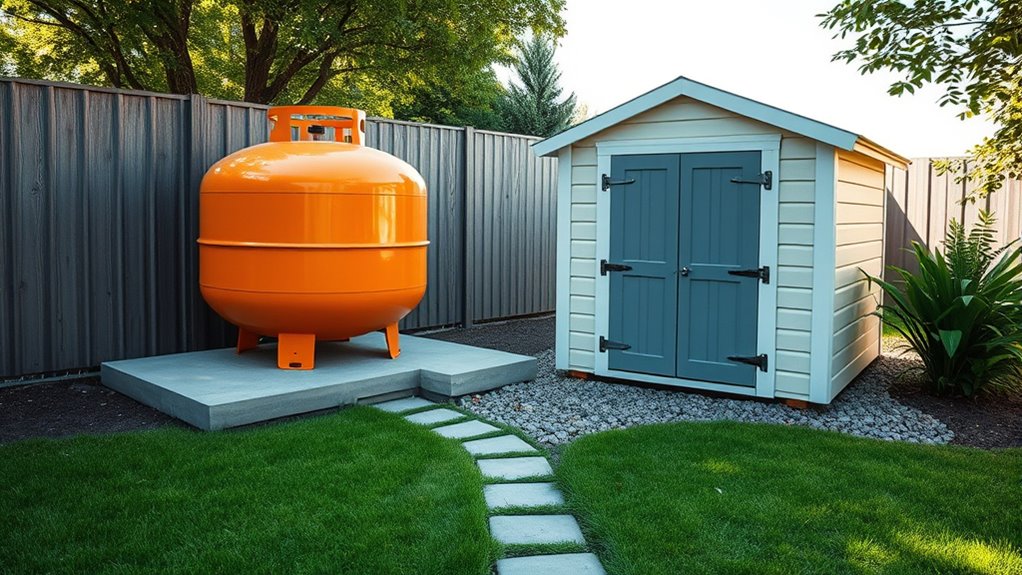
Selecting the right outdoor storage location for propane tanks is essential for safety and compliance. You need to keep tanks at least 20 feet away from buildings to meet OSHA standards. Smaller tanks, like 100-pound cylinders, should stay at least 3 feet from building openings and 5-10 feet from ignition sources. Larger tanks, 250 gallons and above, require a minimum of 10 feet from structures and ignition points. Tanks over 1,000 gallons often need 25 feet clearance, unless isolated from other tanks. Always avoid storing tanks near exits, stairways, or busy areas to reduce hazards during emergencies. An ideal setup includes an open-air cage with a protective roof on a flat, non-combustible surface like concrete or wood, ensuring safety and accessibility. Proper ventilation is also crucial to prevent the buildup of flammable gases and ensure safe storage conditions. Additionally, considering proper tank orientation can help maintain the integrity of the tank and reduce potential risks. Ensuring adequate ventilation and airflow can also significantly improve overall safety during storage.
Ensuring Proper Storage Conditions for Temperature and Environment
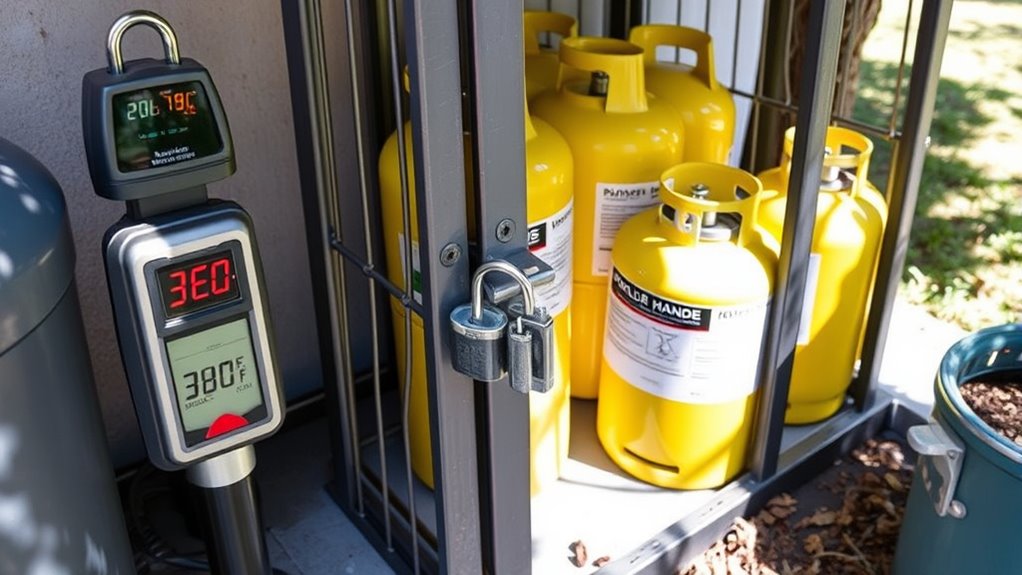
Maintaining proper storage conditions for propane involves controlling temperature and ensuring adequate ventilation. Keep the temperature between −40°F and 120°F (−40°C to 49°C) to prevent pressure issues. Temperatures above 120°F cause expansion, increasing risk of leaks or relief valve activation. Below −40°F, tank integrity may be compromised, especially in winter. Avoid rapid temperature shifts that stress the tank and valves. Ensure good airflow by storing tanks in well-ventilated areas, away from ignition sources and direct sunlight. Use shaded spots to reduce solar heating. Placing tanks upright on level surfaces like concrete slabs prevents corrosion and maintains valve function. Regular inspections for rust, leaks, or damage are essential for safety. Additionally, understanding the 16PF traits can help in assessing the best storage practices for different environments. Proper tank handling techniques are crucial to prevent accidents and ensure longevity of your propane supply.
Correct Orientation and Handling of Propane Cylinders
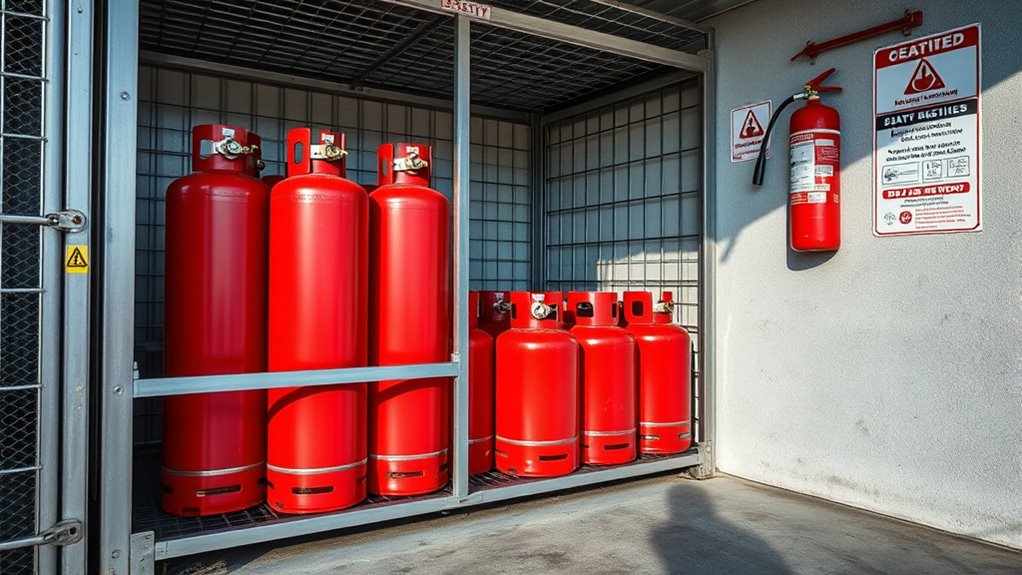
When handling propane cylinders, always keep them upright with the relief valve on top to prevent leaks and internal damage. Secure the cylinders during transport so they can’t tip over or roll, reducing the risk of accidents. Never place cylinders in closed vehicles or leave them exposed to heat, as proper orientation and secure handling are key to safety. Maintaining proper orientation during storage and transport helps ensure the cylinders remain safe and functional. Proper ventilation of storage areas is also crucial to prevent the buildup of potentially dangerous gases. Additionally, regularly inspecting cylinders for damage or corrosion is essential for propane safety and preventing potential hazards. Awareness of angel number soulmate signs can also be helpful in understanding the emotional significance of your environment, including safety-related signs or patterns. Using appropriate storage facilities that are well-ventilated and away from ignition sources further minimizes risks.
Store Tanks Upright
Propane cylinders must always be stored upright to guarantee safe and proper operation of the relief valve, which is designed to release vapor rather than liquid. Keeping tanks vertical ensures the relief valve stays in contact with the vapor space, preventing dangerous liquid release. When stored upright, the cylinder’s foot ring provides stability, preventing tipping. Proper positioning reduces leak risks and helps safety devices like pressure relief valves function correctly. Additionally, maintaining an upright position helps preserve the integrity of the vapor space, which is crucial for safe propane use. Practicing proper storage can also maximize space and organization, making it easier to manage your propane supplies safely. Ensuring proper ventilation considerations during storage further minimizes the risk of dangerous gas buildup.
Proper Relief Valve Position
Ensuring the relief valve on a propane cylinder is correctly oriented is essential for safe operation. The valve should be positioned upward to vent excess pressure safely and effectively. When upright, vented gas is directed away from users and ignition sources, reducing fire or explosion risks. Incorrectly positioned valves can hinder proper relief, increasing hazards during pressure release. Cylinder collars and locator pins help maintain this orientation, ensuring the relief valve stays properly aligned. Even cylinders mounted horizontally, like forklift tanks, are designed with internal features to manage gas flow safely, but their relief valves still need correct positioning. Regular inspections confirm the relief valve remains properly oriented, ensuring it functions correctly when needed and reduces the chance of dangerous overpressure situations. Proper relief valve orientation is crucial to prevent potential safety hazards associated with propane storage. Properly maintaining propane cylinders and following manufacturer instructions for installation and handling can further enhance safety measures. Additionally, ensuring the venting mechanism functions correctly prevents dangerous buildup of pressure and releases excess gas safely. Properly maintaining propane cylinders ensures ongoing safety and functionality over their lifespan.
Secure During Transport
Transporting propane cylinders safely requires keeping them upright and properly secured throughout the journey. This prevents leaks, maintains safety features, and avoids accidents. Make sure the valve is closed and sealed, even if the cylinder is empty. Use supports like tank holders, stabilizers, or sturdy crates to keep cylinders upright and stable. Place them on a flat, stable surface such as the vehicle floor or truck bed, preventing tipping or rolling. Secure them tightly with soft straps, tie-downs, or ropes—avoid chains that could damage the tank. Keep cylinders away from heat, direct sunlight, and inside the vehicle’s ventilated area. Never transport more than four 20-pound cylinders in a closed vehicle, and always check for leaks before and during transit. Implementing risk assessment can help identify potential safety issues during transportation. Proper storage practices also minimize the risk of accidents when the cylinders are not in use. Regularly inspecting cylinders for corrosion or damage can prevent accidents and ensure safety during handling. Additionally, choosing appropriate containers designed for propane storage enhances safety and compliance with regulations.
Conducting Regular Inspections and Maintenance Checks
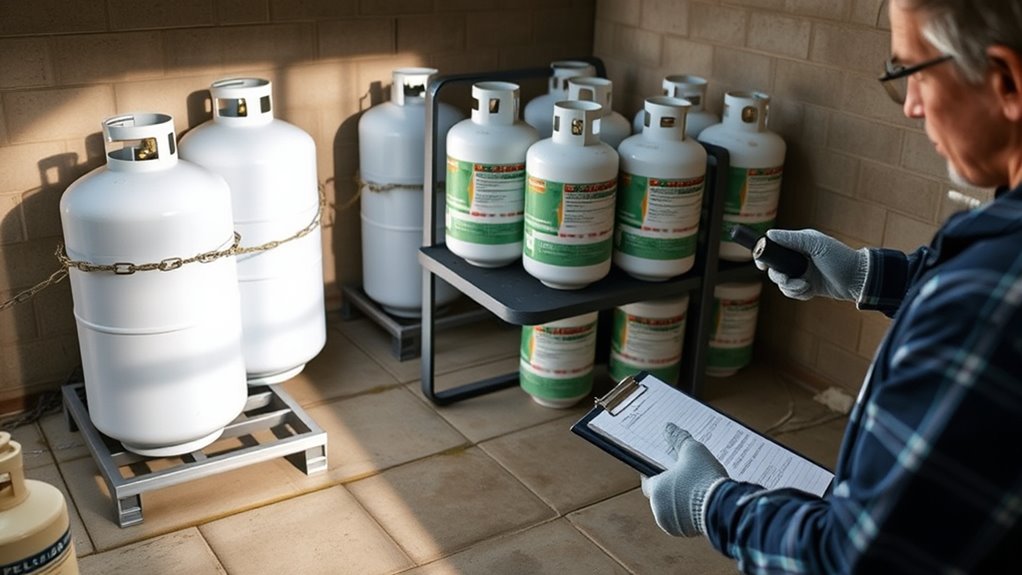
Regular inspections are essential for catching leaks and damage early. You should check the tank’s surface for rust, dents, or corrosion and perform leak tests on fittings and hoses. Staying vigilant helps make certain your propane system remains safe and in good working order. Incorporating preventive maintenance practices can also help identify potential issues before they become serious problems. Additionally, regularly reviewing security measures can ensure your storage practices align with safety recommendations.
Routine Leak Detection
Have you ever wondered how to detect propane leaks before they become dangerous? Regular inspections are your first line of defense. You should check tanks, valves, regulators, hoses, and fittings for damage, rust, or wear that might cause leaks. Confirm your leak detection tools and pressure gauges are properly calibrated and maintained. After any component replacement or system change, test for leaks to verify everything’s secure. Use a maintenance checklist that includes visual inspections, pressure testing, and odor checks—trust your nose for the rotten egg smell. Keep detailed records of all inspections and repairs to track system health and ensure compliance. Staying proactive helps catch issues early, preventing leaks and ensuring your propane storage remains safe.
Visual Tank Assessments
Conducting visual inspections of your propane tank is a vital step in maintaining safety and preventing leaks. Regular checks help identify rust, dents, or damage that could compromise the tank’s integrity. Focus on the tank surface, supports, valves, and piping. Ensure the supports are solid and level, and that no corrosion or deformation exists on skid rails or frames. Examine relief valves for damage, proper rain caps, and unobstructed weep holes. Check markings for clarity and verify manufacturing dates. Inspect piping and regulators to confirm they are secure, undamaged, and properly vented. Keep detailed records of inspections, noting any issues for repair or further testing. Regular visual assessments help catch problems early, ensuring safe propane storage.
| Aspect | What to Look For | Importance |
|---|---|---|
| Tank Surface & Markings | Rust, dents, labels, and safety stamps | Prevent corrosion, ensure traceability |
| Supports & Base | Stability, rust, and level foundation | Avoid tilting or settling |
| Valves & Relief Devices | Damage, rain caps, unobstructed weep holes | Prevent leaks, vent correctly |
| Piping & Regulators | Damage, corrosion, secure installation | Ensure safe operation |
Maintaining Safe Distances and Security Measures
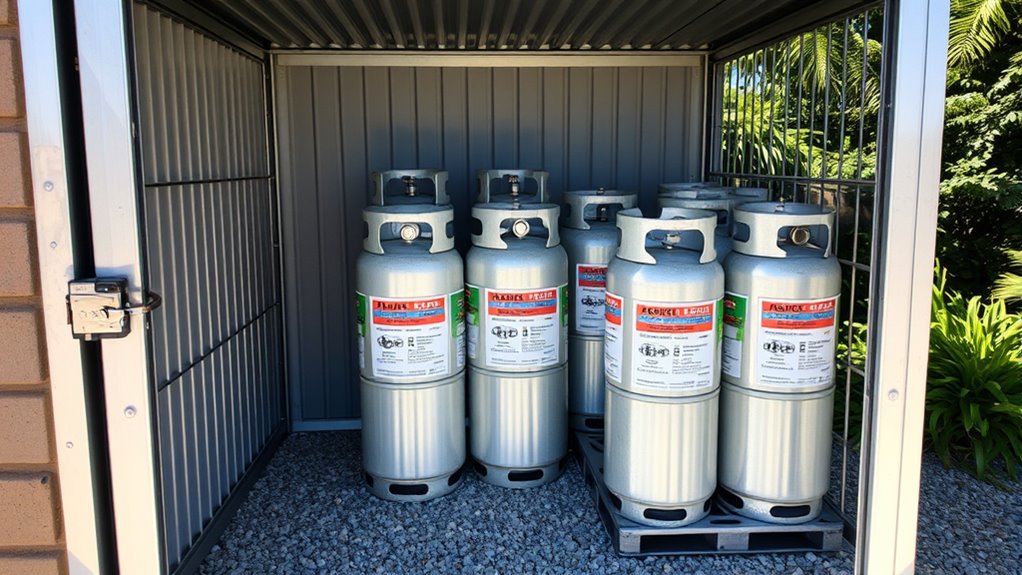
Maintaining safe distances and security measures is crucial for preventing accidents and unauthorized access in propane storage. You need to ensure propane tanks are placed correctly and protected from tampering. Keep cylinders at least 10 feet from buildings and property lines, and larger tanks at least 25 feet away. Store unused cylinders outdoors, 20 feet from structures, away from high-traffic areas. Avoid placing tanks near exits, stairways, or heat sources, and keep them in shaded, ventilated locations. Use safety cages or secure cabinets to prevent unauthorized access, and always lock storage areas. Place cylinders on flat, non-combustible surfaces, avoiding low spots or water accumulation. Regular inspections and adherence to regulations are essential for safe, secure propane storage.
Implementing Safe Rotation and Usage Practices
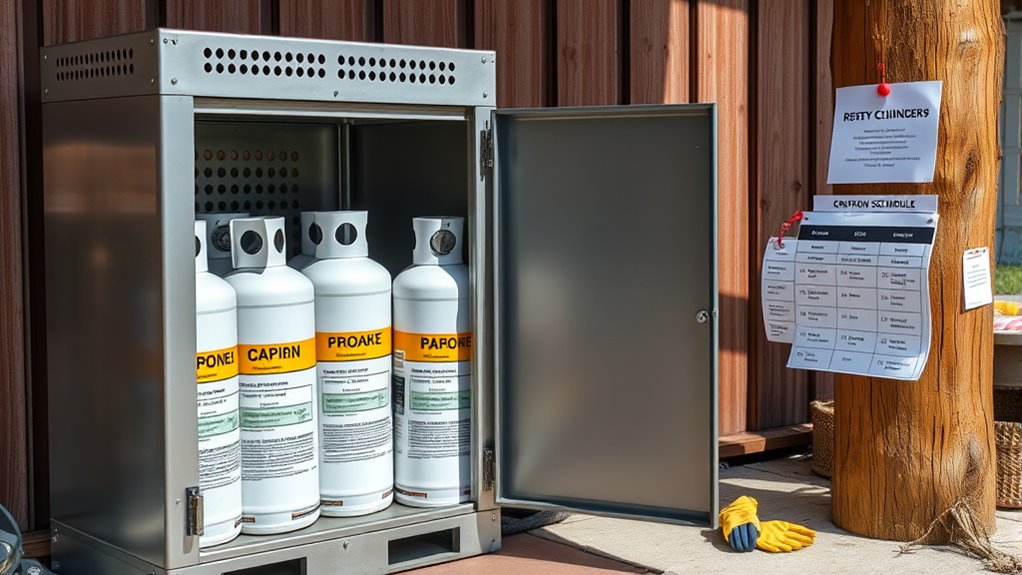
To guarantee safe and efficient propane use, it’s essential to implement proper rotation practices for multiple tanks. Always use the oldest tank first to avoid leaks or deterioration. Label tanks with purchase or refill dates and store newer tanks behind older ones for a natural “first-in, first-out” system. Keep detailed records of inspections, fill dates, and maintenance history. Store tanks outdoors, away from direct sunlight, and avoid indoor or confined space storage. Use this rotation schedule for clarity:
| Tank Number | Purchase Date | Next Replacement Due |
|---|---|---|
| 1 | 01/2023 | 01/2024 |
| 2 | 06/2023 | 06/2024 |
| 3 | 12/2022 | 12/2023 |
Regularly check valves, connections, and keep debris away to maintain safety and efficiency.
Securing Tanks During Transportation and Storage
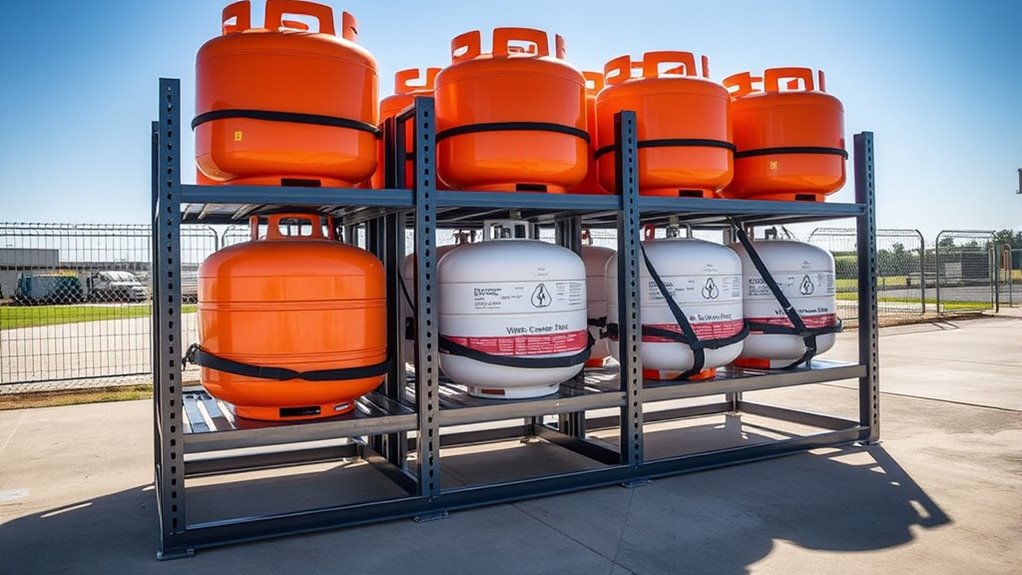
Properly securing propane tanks during transportation and storage is essential to prevent accidents and guarantee safety. You should always transport tanks upright to protect the pressure relief valve and avoid leaks. Use specialized holders, stabilizers, straps, or ropes to keep tanks from rolling or shifting during transit. In pickup beds, trailers, or trunks, fasten tanks securely with supports or stands to maintain an upright position. Never place tanks loosely inside vehicles; instead, wedge them tight or use crates. Ensure good ventilation by transporting tanks in open or well-ventilated areas, and avoid leaving them in hot, enclosed vehicles. Regularly inspect valves for damage and close them before transport. Keep the number of tanks within legal limits to minimize risks.
Recognizing Signs of Damage or Wear in Propane Tanks
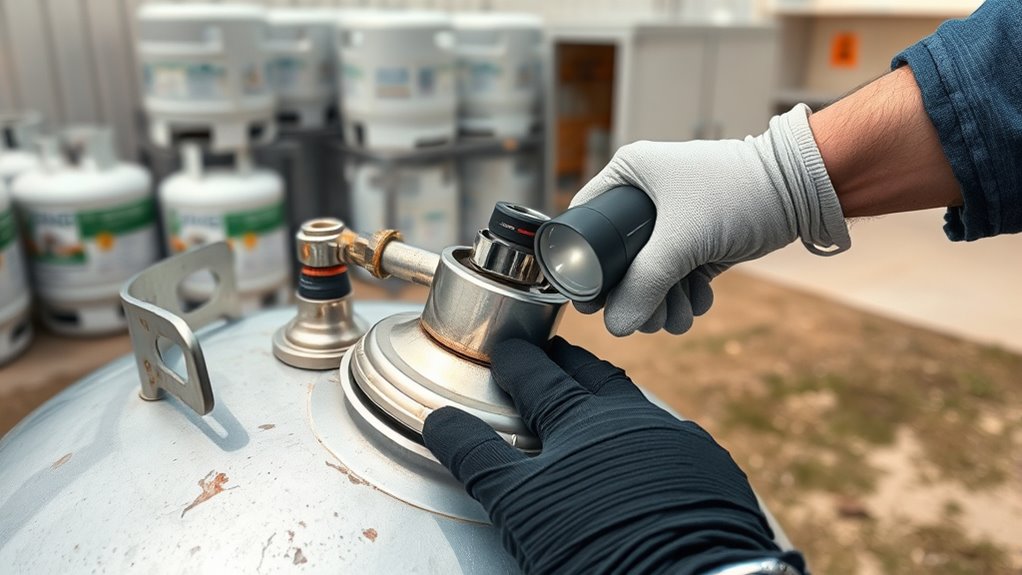
Being able to recognize signs of damage or wear in your propane tanks is crucial for safety. Look for visible rust or corrosion, especially orange or reddish-brown spots, flaking paint, or rust at the bottom, which indicate deterioration. Leaks are critical to detect; a rotten egg smell, hissing sounds, or bubbling from soapy water at connections all signal potential leaks that require immediate action. Physical damage like dents, bulges, or gouges weakens the tank and may cause failures, so inspect for impacts or deformations regularly. Malfunctioning gauges or valves can mislead you about propane levels or restrict flow, so make sure they operate smoothly. External signs like frost, condensation, or pooling water also suggest issues, making routine visual checks essential for safe storage.
Adhering to Local Regulations and Manufacturer Guidelines

Adhering to local regulations and manufacturer guidelines is essential for safe propane storage. These rules guarantee your safety and legal compliance. You must check with local authorities for specific requirements, as they can vary. Follow manufacturer instructions for tank handling, placement, and maintenance. Properly obtaining permits and adhering to zoning laws prevents accidents. Keep in mind that safety zones, setback distances, and environmental controls are often mandated. Failure to comply can lead to fines or dangerous incidents. Always stay updated on regulation changes and manufacturer updates to ensure ongoing safety.
- Store cylinders outdoors, away from buildings, and at least 20 feet from structures
- Follow setback distances based on tank size and local fire codes
- Use appropriate temperature controls to prevent pressure issues
- Position tanks upright with relief valves accessible
- Obtain necessary permits and adhere to jurisdictional rules
Frequently Asked Questions
Can I Store Propane Tanks in My Garage if Well-Ventilated?
Yes, you can store propane tanks in your garage if it’s well-ventilated. Make sure the area has good airflow to disperse any gas leaks and prevent buildup. Keep tanks upright on a stable surface, away from ignition sources, and avoid direct sunlight or extreme temperatures. Regularly check for leaks or damage, and ensure tanks are closed when not in use. Proper ventilation and safety measures are essential for safe storage.
What Are the Best Methods to Secure Tanks During Outdoor Storage?
To secure tanks outdoors, you should anchor them to a stable surface like concrete or a sturdy platform using bolts or threaded rods. Use heavy-duty enclosures with proper ventilation, and lock or remove valve handles to prevent tampering. Secure tanks with stabilizers or anchors, especially in windy conditions. Position them in less accessible areas, and regularly check that they remain upright and undamaged, ensuring they’re both stable and protected.
How Often Should I Inspect My Propane Cylinders for Leaks?
You should inspect your propane cylinders for leaks at least before each use or monthly if they’re in continuous service. Use a soapy water solution around valve connections to spot bubbling, which indicates leaks. Check the valve, hoses, and fittings regularly for cracks, corrosion, or damage. If you notice any signs of leaks, odors, or hissing sounds, immediately turn off the tank and have it inspected by a professional.
Is It Safe to Store Multiple Tanks Together?
Imagine a neat outdoor corner with tanks standing upright, each secured and spaced apart like soldiers on duty. It’s safe to store multiple tanks together as long as you follow regulations—keeping them at least 10 feet from buildings, ignition sources, and property lines. make sure they’re on stable, non-combustible surfaces, well-ventilated, and never stacked or stored indoors. Proper spacing and precautions keep everyone safe.
How Do I Safely Dispose of or Recycle Expired Propane Tanks?
You should never dispose of or recycle expired propane tanks yourself. Instead, contact authorized disposal sites, propane suppliers, or licensed recycling centers. Have professionals safely purge and depressurize the tanks before recycling or disposal. Store the tanks upright outdoors away from heat until they’re taken to the proper facilities. Always follow local regulations and NFPA standards to prevent accidents, and never attempt to puncture or tamper with the tanks yourself.
Conclusion
By following these safety tips, you’ll keep your propane storage area a fortress rather than a ticking time bomb. Think of your tanks as delicate seeds—you must nurture, rotate, and inspect them regularly to make certain they grow safely. When you treat your propane like a trusted partner, you create a secure environment that’s as solid as a fortress wall, giving you peace of mind and safe, reliable energy for your home.

